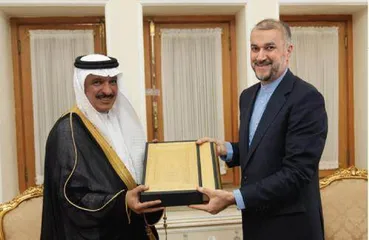New Developments in the Middle Eastamid Great Changes:Features, Challenges and Prospects
作者: Wang Lincong

As the international landscapeevolves at a faster pace inrecent years, the strategic autonomy of the Middle Eastern countries has strengthened. Giving priority to development has become a common choice of countries in the region. There’s a stronger “wave of reconciliation”. The Middle Eastern countries has gained a new posi- tion in the international system, becoming an important force in the Global South. At the same time, amid changes unseen in a century, there are new concepts and solutions to improve global governance and solve global and regional challenges, especially China’s Global Develop- ment Initiative, Global Security Initiative, and Global Civilization Initiative. They can help the Middle East get rid of the security and devel- opment dilemma, and shape a “new Middle East”.
NEW FEATURES OF DEVELOPMENT IN THE MIDDLE EAST
New changes in the development of the Middle East region are mainly: Middle East countries have given priority to development, relations between countries in the region have eased, and national strategic autono- my has been significantly enhanced.
I. Pursuing development as prior- ity at national level
The Middle East countries are taking the opportunities brought by the Fourth Industrial Revolu- tion and focusing on people’sliveli- hood and governance in pursuing development. Facing the regional security and development dilemma, the Middle East countries urgently need to ride on the trend of the new technological revolution. Elites and the general public of Middle East countries have realized that human society is entering the intelligent age from the information age. If they fail to catch up with the new industrial revolution, it will be very difficult to achieve high-quality and sustain- able development. They regarded economic and social development as a key to solving domestic prob- lems and enhancing international influence. Therefore, boosting de- velopment and national governance capacity has become a consensus among the ruling elites and ordinary people in the Middle East. Countries have launched medium- and long- term development plans, such as Türkiye’s Vision 2023, Egypt’s Vision 2030 and Saudi Arabian Vision 2030. In addition, they have also put for- ward development strategies for the Fourth Industrial Revolution, suchas the National Strategy on ArtificialIntelligence of Egypt and Industry 4.0Strategy of the United Arab Emirates(UAE).
II. Promoting reconciliation atregional level
Since 2019, hostility between theregional camps triggered by the Arabupheaval has started to ease. In July2019, officials from Iran and the UAEmet in the Iran capital Tehran to dis-cuss maritime security issues, mark-ing a de-escalation in the confronta-tion between the regional camps. De-escalation between regional powerspicked up speed since 2021. On theone hand, reconciliation was reachedbetween the camps supporting andopposing Muslim Brotherhood. OnJanuary 5, 2021, Emir of Qatar trav-elled to Saudi Arabia for the 41st GulfCooperation Council (GCC) summit.In November 2021 and June 2022,the then Crown Prince Zayed of UAEand Crown Prince Mohammed ofSaudi Arabia were invited to visit Tür-kiye. In the first half of 2022, TurkishPresident Erdogan visited the UAEand Saudi Arabia upon invitation. Inaddition, the camp led by Iran andthe Saudi-led anti-Iranian camp rec-onciled. In 2022, Kuwait and the UAEresumed diplomatic relations of am-bassador level with Iran. Saudi Arabiaand Iran started negotiations from April 2021. With China’s effective mediation efforts, the two countries issued a joint declaration in March 2023 agreeing to restore diplomatic relations. On September 5, Saudi Arabia and Iran exchangedambassa- dors, completing the last step in the resumption of diplomatic relations. This is a major symbol of the recon- ciliation wave in the Middle East. It also facilitated Syria’s return to the Arab League, pointing to the continu- ing reconciliation in the Middle East.
The reconciliation wave in the Middle East is a rational choice of the regional countries based on their security and economic assessments. In terms of security, continued mili- tary conflict and confrontation be- tween the regional powers not only stand in the way towards political ob- jectives and strategic gains, but also worsens the security or increases dip- lomatic isolation. In terms of econo- my, the involvement of Middle East powers in the regional conflicts costs huge financial resources and has negative economic, social and politi- cal impacts. The economicslump ofTürkiye and the large-scale protests in Iran are enormously challenging to the political stability. Saudi Arabia and the UAE are at a critical stage of economic diversification and trans- formation. Spending a lot of money on security diverts the money that should go to economic transforma- tion. Therefore, the regional coun- tries have chosen reconciliation to create a peaceful environment for development. It is worth noting that strategic contraction in the Middle East and dwindling US influence in regional affairs have made US drift away from regional allies. On the contrary, China’s long-term efforts to promote peace and the role of “guarantor” in the Saudi-Iran recon- ciliation have become an important external factor for the Middle East countries to seek reconciliation.